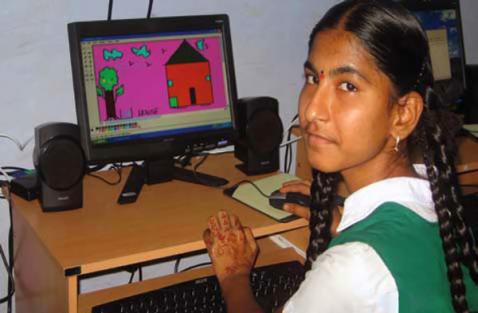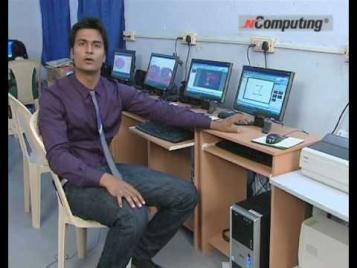CASO DE ÉXITO
1.8 Million Students in India Join the Digital Revolution
Computer skills are becoming as important as math, language and science education, and governments around the world are looking for the most efficient ways to provide computing access for their students.

Students can now use computers for classwork in the school’s computer lab.
Andhra Pradesh is the largest state in Southern India with a population of roughly 70 million people. The government wanted to bring computing access to its school system, but had several critical challenges. First, funding for computer labs was very limited, so revolutionary approaches to providing wide-scale access were needed. Second, most of the schools were located in areas where electricity was unreliable, often only available for two hours per day. So an energy-efficient computing solution was required. Finally, since the schools were spread throughout a large geographically diverse area, planning, installing and supporting computer labs was going to be challenging. The government needed a breakthrough solution that was ultra low-cost, energy efficient, and easy to deploy.
NComputing: the Path to Success
The government evaluated various computing models, including virtual desktops. After an extensive evaluation, the government was convinced that a shared computing solution would meet their performance requirements, cost less to purchase, and use a fraction of the power.
The NComputing solution is based on a simple fact: today’s PCs are so powerful that the vast majority of applications only use a small fraction of the computer’s capacity. NComputing’s virtualization software and hardware tap this unused capacity so that it can be simultaneously shared by multiple students. Each student’s monitor, keyboard, and mouse connect to the shared PC through a small and very durable NComputing access device. The access device itself has no CPU, memory, or moving parts—so it’s rugged, durable, and easy to deploy and maintain. By spreading out the cost of the shared computer, schools can provide up to four times the number of stations for the same money.
The NComputing devices only use 1 watt of electricity, so the entire 10-seat computing lab uses 90% less electricity compared to an all-PC lab.
Installing 5,000 Schools in Record Time
Given the challenge of deploying in 5,000 schools, the government chose to use a BOOT model—build, own, operate, transfer—and engaged educational companies to build and equip the computer labs, hire and train teachers, operate the labs for 5 years, and then transfer them to the government at the end of the contract period.
NIIT, Educomp, Everonn, IEG, and a number of other education system integrators were awarded the contract to build and operate labs. NComputing worked with local PC OEMs, including HP, Acer and HCL, to install the X-series kits in their factories and ship them to each site. This teamwork approach resulted in most labs becoming operational within just a few months.
Enabling a Bright Future for India’s Students
Over 1.8 million students now have computer access. After initial training to teach basic computer skills, students quickly move to advanced courseware in math, science, and social studies. Access to the Internet allows students to perform research that could not be done with the limited resources available in a school library. This project was indeed the first big step in empowering the children of Andhra Pradesh to join the digital world.
Suggested reading




